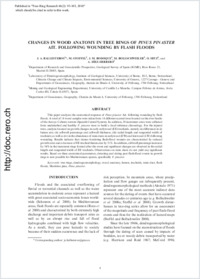Changes in wood anatomy in tree rings of Pinus pinaster Ait. following wounding by flash floods
- Ballesteros, J. A. Department of Research and Geoscientific Prospective, Geological Survey of Spain (IGME), Madrid, Spain
- Stoffel, Markus Laboratory of Dendrogeomorphology, Institute of Geological Sciences, University of Berne, Switzerland - Climatic Change and Climate Impacts, Institute for Environmental Sciences, University of Geneva, Switzerland - Department of Geosciences, Geography, Fribourg, Switzerland
- Bodoque, J. M. Mining and Geological Engineering Department, University of Castilla La Mancha, Toledo, pain
- Bollschweiler, Michelle Laboratory of Dendrogeomorphology, Institute of Geological Sciences, University of Berne, Switzerland - Climatic Change and Climate Impacts, Institute for Environmental Sciences, University of Geneva, Switzerland - Department of Geosciences, Geography, Fribourg, Switzerland
- Hitz, Oliver Department of Geosciences, Geography, Fribourg, Switzerland
- Díez-Herrero, A. Department of Research and Geoscientific Prospective, Geological Survey of Spain (IGME), Madrid, Spain
-
2010
Published in:
- Tree-Ring Research. - 2010, vol. 66, no. 2, p. 93-103
Tree rings
Dendrogeomorphology
Wood anatomy
Lumen
Tracheids
Resin ducts
Flash floods
Maritime pine
Pinus pinaster Ait
English
This paper analyzes the anatomical response of Pinus pinaster Ait. following wounding by flash floods. A total of 14 wood samples were taken from 14 different scarred trees located on the river banks of the Arroyo Cabrera torrent (Spanish Central System). In addition, 20 increment cores were collected from undisturbed and healthy P. pinaster trees to build a local reference chronology. For the injured trees, analysis focused on growth changes in early earlywood (EE) tracheids, namely on differences in (i) lumen size; (ii) cell-wall percentage and cell-wall thickness; (iii) radial length and tangential width of tracheids; as well as (iv) in the abundance of resin ducts in earlywood (EW) and latewood (LW) following wounding. Results indicate that tissues bordering flash-flood wounds are characterized by reduced growth rates and a decrease of EE tracheid lumen area by 51%. In addition, cell-wall percentage increases by 34% in the increment rings formed after the event and significant changes are observed in the radial length and tangential width of EE tracheids. Observations on resin ducts do not yield any significant results. Based on these anatomical parameters, detecting and dating past flash-flood events in growth rings is now possible for Mediterranean species, specifically P. pinaster.
- Faculty
- Faculté des sciences et de médecine
- Department
- Département de Géosciences
- Language
-
- English
- Classification
- Meteorology, climatology
- License
-
License undefined
- Identifiers
-
- RERO DOC 18328
- DOI 10.3959/2009-4.1
- Persistent URL
- https://folia.unifr.ch/unifr/documents/301597
Statistics
Document views: 215
File downloads:
- pdf: 271
